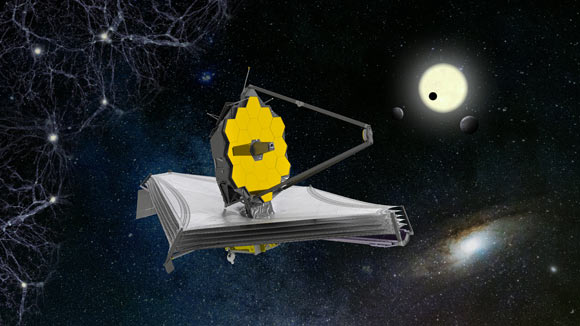Webb’s Camera Captures Its First Photons of Starlight
Feb 8, 2022 by News Staff / Source
On February 3, 2022, astronomers saw the first photons of starlight that traveled through the NASA/ESA/CSA James Webb Space Telescope and were detected by its Near Infrared Camera (NIRCam) instrument. The detection marks the first of many steps to capture images that are at first unfocused and use them to slowly fine-tune the Webb telescope. This is the beginning of the three-month process of aligning the telescope, but so far the initial results match expectations and simulations.

An artist’s impression of the James Webb Space Telescope. Image credit: ESA.
“With deployment of the mirror segments now complete, and the instruments turned on, we’ve begun the numerous steps required to prepare and calibrate the telescope to do its job,” said Dr. Lee Feinberg from NASA’s Goddard Space Flight Center, Dr. Scott Acton and Dr. Chanda Walker of Ball Aerospace, and their colleagues from the Webb team.
The researchers will now use the NIRCam data to progressively align the Webb telescope.
They developed and demonstrated the algorithms using a 1/6th scale model telescope testbed.
They’ve simulated and rehearsed the process many times and are now ready to do this with Webb.
The process will take place in seven phases over the next three months, culminating in a fully aligned telescope ready for instrument commissioning.
The images taken by Webb during this period will not be ‘pretty’ images like the new views of the Universe the telescope will unveil later this summer.
They strictly serve the purpose of preparing the telescope for science.
To work together as a single mirror, the telescope’s 18 primary mirror segments need to match each other to a fraction of a wavelength of light — approximately 50 nm.
To put this in perspective, if the Webb primary mirror were the size of the United States, each segment would be the size of Texas, and the team would need to line the height of those Texas-sized segments up with each other to an accuracy of about 3.8 cm (1.5 inches).
“The telescope commissioning process will take much longer than previous space telescopes because Webb’s primary mirror consists of 18 individual mirror segments that need to work together as a single high-precision optical surface,” the scientists said.
“The steps in the commissioning process include: segment image identification, segment alignment, image stacking, coarse phasing, fine phasing, telescope alignment over instrument fields of view, iterate alignment for final correction.”
_____
This article is based on text provided by the National Aeronautics and Space Administration.
http://www.sci-news.com/astronomy/webbs-first-photons-starlight-10531.html?utm_source=feedburner&utm_medium=email
Thanks to: http://www.sci-news.com
Feb 8, 2022 by News Staff / Source
On February 3, 2022, astronomers saw the first photons of starlight that traveled through the NASA/ESA/CSA James Webb Space Telescope and were detected by its Near Infrared Camera (NIRCam) instrument. The detection marks the first of many steps to capture images that are at first unfocused and use them to slowly fine-tune the Webb telescope. This is the beginning of the three-month process of aligning the telescope, but so far the initial results match expectations and simulations.

An artist’s impression of the James Webb Space Telescope. Image credit: ESA.
“With deployment of the mirror segments now complete, and the instruments turned on, we’ve begun the numerous steps required to prepare and calibrate the telescope to do its job,” said Dr. Lee Feinberg from NASA’s Goddard Space Flight Center, Dr. Scott Acton and Dr. Chanda Walker of Ball Aerospace, and their colleagues from the Webb team.
The researchers will now use the NIRCam data to progressively align the Webb telescope.
They developed and demonstrated the algorithms using a 1/6th scale model telescope testbed.
They’ve simulated and rehearsed the process many times and are now ready to do this with Webb.
The process will take place in seven phases over the next three months, culminating in a fully aligned telescope ready for instrument commissioning.
The images taken by Webb during this period will not be ‘pretty’ images like the new views of the Universe the telescope will unveil later this summer.
They strictly serve the purpose of preparing the telescope for science.
To work together as a single mirror, the telescope’s 18 primary mirror segments need to match each other to a fraction of a wavelength of light — approximately 50 nm.
To put this in perspective, if the Webb primary mirror were the size of the United States, each segment would be the size of Texas, and the team would need to line the height of those Texas-sized segments up with each other to an accuracy of about 3.8 cm (1.5 inches).
“The telescope commissioning process will take much longer than previous space telescopes because Webb’s primary mirror consists of 18 individual mirror segments that need to work together as a single high-precision optical surface,” the scientists said.
“The steps in the commissioning process include: segment image identification, segment alignment, image stacking, coarse phasing, fine phasing, telescope alignment over instrument fields of view, iterate alignment for final correction.”
_____
This article is based on text provided by the National Aeronautics and Space Administration.
http://www.sci-news.com/astronomy/webbs-first-photons-starlight-10531.html?utm_source=feedburner&utm_medium=email
Thanks to: http://www.sci-news.com






 Sat Mar 23, 2024 11:33 pm by globalturbo
Sat Mar 23, 2024 11:33 pm by globalturbo

